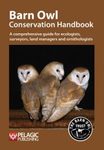![Der Rauhfußkauz [Tengmalm's Owl] Der Rauhfußkauz [Tengmalm's Owl]]()
Click to have a closer look
About this book
Customer reviews
Related titles
About this book
Language: German
While the boreal or Tengmalm's owl, native to Eurasia, was well known during the time of the Old Brehm, people had little knowledge of them at the beginning of this century. Their hidden and nocturnal habits make them difficult to observe. Only when people stopped killing or capturing birds, and started paying attention to their behaviour and their vocal utterances, was the boreal owl rediscovered and is now found as a breeding bird in all low German mountain ranges and also in the northern German lowlands. The habitat of the Little Owl-like bird, which got its name after its feathered feet, are deep silent forests, where they live as cavity nesters in old trees. Their beautiful melodious calls widely betray their presence. Already in early March, with often deep winter conditions, they begin their breeding. The food supply – a good or bad mouse or lemming year – determines the number of eggs these mice hunters have. When food is lacking the birds undertake long migrations, but normally they are non-migratory birds. Their main enemy is the pine marten, but also the hawk and larger owl species are adversaries. The protection of boreal owls, like that of all other owl species that are so useful for humans, is necessary for the preservation of forest biotopes, and it is desirable that this notion of nature conservation is taken into account when drawing up forestry measures.
Summary in German:
Während der in Eurasien beheimatete Rauhfußkauz zur Zeit des Alten Brehm recht gut bekannt war, hatte man am Anfang dieses Jahrhunderts wenig Ahnung von ihm. Seine versteckte und nächtliche Lebensweise erschwerte die Beobachtung. Erst als man anfing, Vögel nicht nur zu töten oder zu fangen, sondern auf ihr Verhalten, ihre stimmlichen Äußerungen zu achten, wurde der Rauhfußkauz wiederentdeckt und ist nun in allen deutschen Mittelgebirgen und auch im norddeutschen Tiefland als Brutvogel festgestellt worden. Der Biotop des dem Steinkauz ähnlichen Vogels, der seinen Namen nach den befiederten Füßen erhalten hat, sind tiefe stille Wälder, wo er als Höhlenbrüter alte Bäume bewohnt. Seine schönen melodischen Rufe verraten seine Anwesenheit weithin. Schon Anfang März, bei oft noch tief winterlichen Witterungsverhältnissen, beginnt er seine Brut. Nach dem Nahrungsangebot - in guten oder schlechten Mäuse- oder Lemmingjahren - richtet sich die Eizahl dieser Mäusejäger. Bei Nahrungsmangel unternehmen die Vögel weite Wanderungen, während sie im allgemeinen Standvögel sind. Ihr Hauptfeind ist der Baummarder, auch der Habicht und die größeren Eulenarten stellen ihnen nach. Auch der Schutz des Rauhfußkauzes, wie der aller anderen auch für den Menschen so nützlichen Eulenarten, ist zur Erhaltung der Biozönose Wald notwendig, und es ist wünschenswert, daß bei forstwirtschaftlichen Maßnahmen diese Forderung des Naturschutzes berücksichtigt wird.
Customer Reviews






![Der Rauhfußkauz [Tengmalm's Owl] Der Rauhfußkauz [Tengmalm's Owl]](http://mediacdn.nhbs.com/jackets/jackets_resizer_xlarge/52/52813.jpg?height=620)
![Der Rauhfußkauz [Tengmalm's Owl]](http://mediacdn.nhbs.com/jackets/jackets_resizer/52/52813.jpg)
![Der Rauhfußkauz [Tengmalm's Owl]](http://mediacdn.nhbs.com/jackets/jackets_resizer/52/52813_1.jpg)
![Der Rauhfußkauz [Tengmalm's Owl]](http://mediacdn.nhbs.com/jackets/jackets_resizer/52/52813_2.jpg)
![Der Rauhfußkauz [Tengmalm's Owl]](http://mediacdn.nhbs.com/jackets/jackets_resizer/52/52813_3.jpg)




![Die Seeadler [White-Tailed Eagle]](http://mediacdn.nhbs.com/jackets/jackets_resizer_medium/52/52805.jpg?height=150&width=106)
![Die Teichralle [The Common Moorhen]](http://mediacdn.nhbs.com/jackets/jackets_resizer_medium/52/52926.jpg?height=150&width=105)
![Die Wasseramsel [The White-Throated Dipper]](http://mediacdn.nhbs.com/jackets/jackets_resizer_medium/24/247214.jpg?height=150&width=107)
![Der Wespenbussard [The Honey Buzzard]](http://mediacdn.nhbs.com/jackets/jackets_resizer_medium/25/25905.jpg?height=150&width=103)



![Die Ausgestorben Vögel der Welt [The Extinct Birds of the World]](http://mediacdn.nhbs.com/jackets/jackets_resizer_medium/52/52960.jpg?height=150&width=104)

![Die Blaumeise [Blue Tit]](http://mediacdn.nhbs.com/jackets/jackets_resizer_medium/13/130204.jpg?height=150&width=101)
![Lärmvögel, Turakos und Pisangfresser [Go-Away-Birds, Turacos and Musophaga]](http://mediacdn.nhbs.com/jackets/jackets_resizer_medium/17/172673.jpg?height=150&width=104)



















![Das Okapi [The Okapi]](http://mediacdn.nhbs.com/jackets/jackets_resizer_medium/16/164634.jpg?height=150&width=107)
![Verhalten der Gazellen [Behaviour of Gazelles]](http://mediacdn.nhbs.com/jackets/jackets_resizer_medium/20/203915.jpg?height=150&width=106)
![Das Blesshuhn: Fulica atra [Eurasian Coot]](http://mediacdn.nhbs.com/jackets/jackets_resizer_medium/17/172773.jpg?height=150&width=107)
![Die Saatkrähe [Rook]](http://mediacdn.nhbs.com/jackets/jackets_resizer_medium/17/172660.jpg?height=150&width=106)